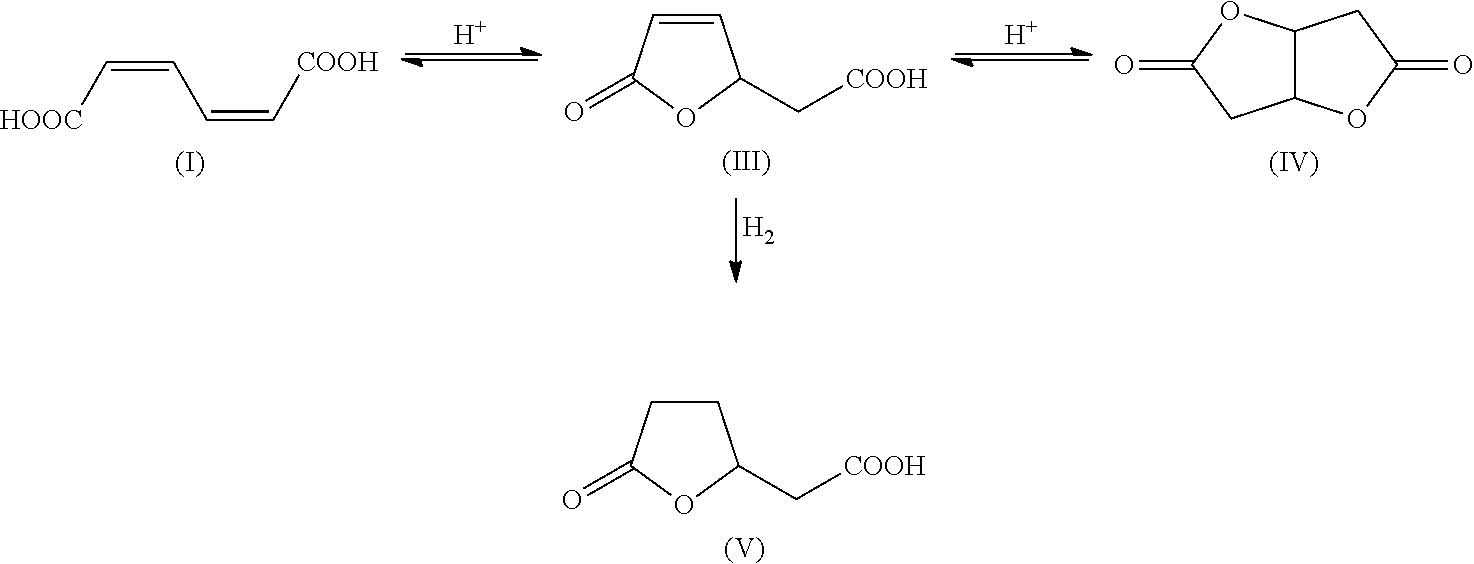Process for producing nylon-6,6
a technology of nylon-6,6 and process, which is applied in the field of polyamide6 preparation, can solve the problems of affecting the economic viability of the celanese process, requiring a considerable level of distillation complexity to produce pure hexane-1,6-diol, and reducing the yield of adipic acid, so as to achieve high adipic acid yield and reduce the cos
- Summary
- Abstract
- Description
- Claims
- Application Information
AI Technical Summary
Benefits of technology
Problems solved by technology
Method used
Image
Examples
example 1
[0221]Preparation of Muconic Acid
[0222]cis,cis-Muconic acid was prepared by the method in K. M. Draths, J. W. Frost, J. Am. Chem. Soc., 116 (1994), pages 399-400, biocatalytically from D-glucose by means of the Escherichia coli mutant AB2834 / pKD136 / pKD8.243A / pKD8.292.
example 2
[0223]Preparation of Adipic Acid
[0224]A 250 mL stirred autoclave was charged with a suspension of 24 g of the cis,cis-muconic acid and 1 g of Raney Ni in 56 g of water, hydrogen was injected to 3 MPa and the autoclave was heated to 80° C. On attainment of the temperature of 80° C., the pressure was increased to 10 MPa and a sufficient amount of further hydrogen was metered in to keep the pressure constant. After a reaction time of 12 h, the autoclave was cooled to a temperature of 60° C. and decompressed to standard pressure, and the catalyst was filtered out of the solution. Thereafter, the mixture was cooled gradually to 20° C., in the course of which adipic acid crystallized out as a white solid. In the solution, as well as adipic acid, it was still possible to detect lactone (V). The yield of adipic acid was 95% and that of lactone (V) 5%. The mother liquor comprising adipic acid and lactone (V) is recycled into the hydrogenation stage.
example 3
[0225]Preparation of hexane-1,6-diol
[0226]15 g / h of a mixture of 33% of the adipic acid and 67% water were hydrogenated at a feed temperature of 70° C. in a 30 mL tubular reactor in which 20 mL of catalyst (66% CoO, 20% CuO, 7.3% Mn3O4, 3.6% MoO3, 0.1% Na2O, 3% H3PO4, preparation according to DE 23 21 101 A; 4 mm extrudates; activation with hydrogen up to 300° C.) were present, in trickle mode at a temperature of 230° C. and a pressure of 25 MPa. The reactor output was separated from excess hydrogen in a separator (offgas rate 2 L / h) and passed partly through a pump as circulation stream back to the head of the reactor, where it is combined with the feed stream (feed:circulation=1:10), and partly into an output vessel. The outputs were analyzed by gas chromatography (% by weight, method with internal standard). The yield of hexane-1,6-diol was 94%; the yield of adipic acid was 98.5%. As further products, 3% 6-hydroxycaproic acid, 1% hexane-1,6-diol 6-hydroxycaproate and 1% hexanol w...
PUM
| Property | Measurement | Unit |
|---|---|---|
| Temperature | aaaaa | aaaaa |
| Temperature | aaaaa | aaaaa |
| Percent by mass | aaaaa | aaaaa |
Abstract
Description
Claims
Application Information
 Login to View More
Login to View More - R&D
- Intellectual Property
- Life Sciences
- Materials
- Tech Scout
- Unparalleled Data Quality
- Higher Quality Content
- 60% Fewer Hallucinations
Browse by: Latest US Patents, China's latest patents, Technical Efficacy Thesaurus, Application Domain, Technology Topic, Popular Technical Reports.
© 2025 PatSnap. All rights reserved.Legal|Privacy policy|Modern Slavery Act Transparency Statement|Sitemap|About US| Contact US: help@patsnap.com



